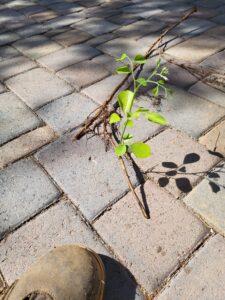The Sissoo Tree
The tree you should never have planted or have on your property.
The Sissoo tree, also known as the shisham tree or the North Indian rosewood, is listed as one of the most invasive trees of the world due to its root structure, which can reach great distances from the trunk of the tree. Our customers have found roots and shoots sprouting from them up to 100 feet away from the trunk.
Examples of the problems these trees’ root systems have caused include plumbing damage, disruption of a house’s retaining walls, destroyed irritation lines and more. House foundations have even been lifted from root invasion, causing severe structural damage to the house. We’ve also seen the roots damage pools and had a customer in Tempe that had a root pushing in the side of the pool.

The aggressive Sissoo tree root structure is key to the plant’s survival and propagation in its native environment, where it needed to establish a strong root system to survive in poor soil. Consequently, this tree is an excellent choice where soil erosion is a concern.
For example, these trees have been planted to help secure the soil from eroding during heavy rainstorms along the Phoenix freeway system where the road system is built below ground level. They can even be nice shade providing trees if they are placed far enough away from any underground utilities or structures.
Gravely’s Septic Service
Gravely’s Septic Service found Sissoo tree roots inside of septic tanks as well as the drainpipe leading to the septic tank due to the tree’s proximity to the septic system – impacting several customers. The roots’ disruption led to the thousands of dollars in damages for the customers.
Cortina
The Cortina neighborhood in Queen Creek was also negatively impacted by the Sissoo trees – with a community customer referring to them as evil devil trees like poltergeists because of the roots continuing to sprout new tree plants all over the yard after the trees were removed. The tree’s roots had become intertwined with the customer’s lawn, causing continuous damage to the irrigation system, which required costly repairs.
The New Heights Tree Service team was able to solve this problem and permanently eliminated the possibility of the tree coming back using a special procedure to permanently remove the tree.
We then permanently removed seven other trees around the property that were lifting pavers and causing dangerous trip hazards. In one case, the roots were 60 feet away from the tree and working its way towards the pool. This could have led to more destruction as the Sissoo tree’s roots have been known to penetrate walls to reach water.
